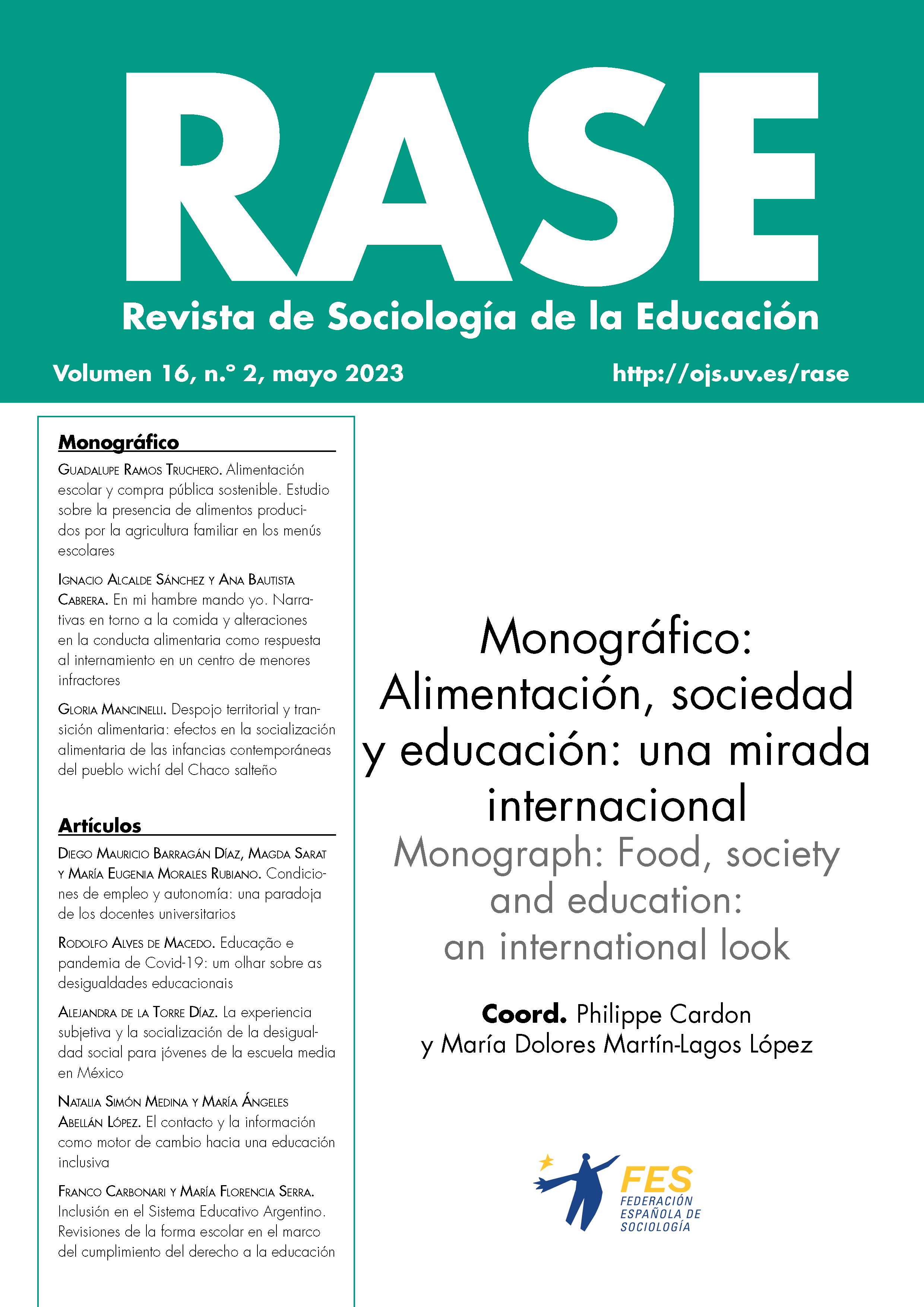I Command my Hunger. Narratives Around the Food and the Eating Disorders as an Answer to the Internment in a Prison for Juvenile Offenders
DOI:
https://doi.org/10.7203/RASE.16.2.26004Keywords:
Eating disorders, recruitment, juvenile offender, domination, diet. Abstract
Abstract
This article analyzes the effects of the recruitment for the juvenile offenders. Specifically, in one object: the behavior in relation with the food and the different disorders about it as an empiric way to observe it. The reactions produced by the minors in their feeding process reflects the cultural shock about the internment and the cultural distance between their customs and the regulated and healthy diet, as well as their resistance to accept this new role as juvenile offenders. We have used the American Psychiatric Association´s manual as ethnographical tool to regroup the different speeches around the eating disorders. An ethnographic research about the speeches around the feeding behavior disturbances in a sample of children, who are carrying out an internment in a center for juvenile offenders and the relations between cultural aspects and the prison meanings. Dominated bodies, Goffman-roles performance or the pressure of the society over the person finds the feeding disturbances as a way of resistance against them.
 Downloads
Downloads
 References
References
American Psychiatric Association (2014). DSM-5. Manual Diagnóstico y Estadístico de los Trastornos Mentales DSM-5. American, Arlington: Psychiatric Pub.
Behar Rosa; Figueroa Gustavo (2010). Trastornos de la conducta alimentaria. Santiago de Chile: Editorial Mediterráneo.
Bourdieu, Pierre (1988). La distinción. Madrid: Taurus.
Bourdieu, Pierre (2009). La eficacia simbólica. Religión y política. Buenos Aires: Editorial Biblos.
Bourdieu, P. (2000). La dominación masculina. Barcelona: Anagrama.
Csordas, T. J. (1990). “Embodiment as a paradigm for Anthropology”. Ethos, 18 (1): 5-47.
De Gracia, M.; Marcó, M.; Trujano, P. (2007). “Factores asociados a la conducta alimentaria en preadolescentes”. Psicothema, 19(4): 646-653.
Deiana, Federica (2011). “Nadie dijo que fuera fácil ser una princesa”. Revista de Antropología Iberoamericana,6(2): 215-252.
Di Silvestre, Cristina (1998). “Somatización y percepción subjetiva de la enfermedad”. Cinta de Moebio, 4:1-11.
Durkheim, Emile; Mauss, Marcel (1996 [1901]). Sobre algunas formas primitivas de clasificación. Contribución al estudio de las representaciones colectivas. Barcelona: Ariel.
Foucault, M. (1975). Los anormales, Buenos Aires: Fondo de Cultura Económica.
Gracia-Arnaiz, Mabel; Comelles, Josep M. (eds.) (2007). No comerás. Narrativas sobre comida, cuerpo y género en el nuevo milenio. Barcelona: Icaria.
Gracia-Arnaiz, Mabel (2014). “Comer o no comer ¿es esa la cuestión?: una aproximación antropológica al estudio de los trastornos alimentarios”. Politica y Sociedad, 51(1):7 3-94.
Goffman, E. (2001). Internados: ensayos sobre la situación social de los enfermos mentales. Buenos Aires: Amorrortu.
Harris, M. (1999). Bueno para comer. Enigmas de alimentación y cultura. Madrid: Alianza.
Le Breton, D. (2002). Antropología del cuerpo y modernidad. Buenos Aires: Nueva Visión.
López García, Julián (2003). “Algunas consideraciones metodológicas en los trabajos de campo en antropología de la alimentación. Experiencias con mayas-ch´orti´ del oriente de Guatemala”. Revista de Antropología Social, 12: 223-241
López García, Julián; Juárez, Lorenzo Mariano; Medina, F. Xavier (2016). “Usos y significados contemporáneos de la comida desde la antropología de la alimentación en América Latina y España.” Revista de Dialectologia y Tradiciones Populares, 71(2): 327-370.
McArthur, Laura H.; Holbert, Donald; y Pena, Manuel (2005). “An exploration of the attitudinal and perceptual dimensions of body image among male and female adolescents from six Latin American cities”. Adolescence, 40(160): 801-16.
Mancilla, Juan M.; Gómez-Peresmitré, Gilda; Alvarez, Georgina; et al. (2006). “Trastornos del comportamiento alimentario en México”, en Juan M. Mancilla, Gilda Gómez-Peresmitré (eds), Trastornos alimentarios en Hispanoamérica. México D. F.: Manual Moderno, 123-171.
Ricciardelli, Lina A.; McCabe, Marita P.; Lillis, Jessica; et al. (2006). “A longitudinal investigation of the development of weight and muscle concerns among preadolescent boys”. Journal of Youth and Adolescence, 35(2): 168-178.
Smolak, Linda; Levine, Michael P. (1996). “Media as a context for the development of disordered eating”, en Linda Smolak, Michael P. Levine, Ruth Striegel-Moore (eds), The developmental psychopathology of eating disorders: Implications for research, prevention, and treatment. Hillsdale: Lawrence Erlbaum Associates. 235-237.
Stice, Eric (2002). “Risk and maintenance factors for eating pathology: a meta-analytic review”. Psychological bulletin, 128(5): 825-848.
Venceslao, M.; Delgado, M. (2017). “Somatizaciones del internamiento en un centro de justicia juvenil. La participación de los dominados en su propia dominación”. AIBR Revista de Antropología Iberoamericana, 12(2):193-214. https://doi.org/10.11156/aibr.120206
Wacquant, Loïc (2000). Las cárceles de la miseria. Madrid: Alianza.
Wacquant, Loïc (2007). Los Condenados de la Ciudad. Gueto, periferia y estado. Madrid: Siglo XXI.
Downloads
Published
How to Cite
-
Abstract352
-
PDF (Español)202
Issue
Section
License
![]()
This work is licensed under a Creative Commons Reconocimiento-NoComercial-CompartirIgual 4.0 Internacional.




